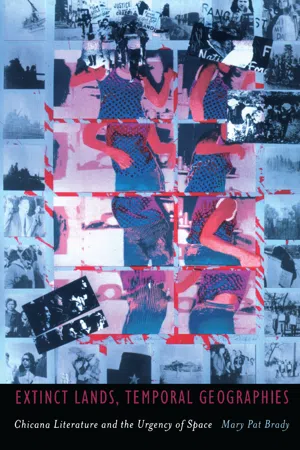
Extinct Lands, Temporal Geographies
Chicana Literature and the Urgency of Space
- English
- PDF
- Available on iOS & Android
Extinct Lands, Temporal Geographies
Chicana Literature and the Urgency of Space
About This Book
A train station becomes a police station; lands held sacred by Apaches and Mexicanos are turned into commercial and residential zones; freeway construction hollows out a community; a rancho becomes a retirement community—these are the kinds of spatial transformations that concern Mary Pat Brady in Extinct Lands, Temporal Geographies, a book bringing together Chicana feminism, cultural geography, and literary theory to analyze an unusual mix of Chicana texts through the concept of space. Beginning with nineteenth-century short stories and essays and concluding with contemporary fiction, this book reveals how Chicana literature offers a valuable theoretics of space.
The history of the American Southwest in large part entails the transformation of lived, embodied space into zones of police surveillance, warehouse districts, highway interchanges, and shopping malls—a movement that Chicana writers have contested from its inception. Brady examines this long-standing engagement with space, first in the work of early newspaper essayists and fiction writers who opposed Anglo characterizations of Northern Sonora that were highly detrimental to Mexican Americans, and then in the work of authors who explore border crossing. Through the writing of Sandra Cisneros, Cherríe Moraga, Terri de la Peña, Norma Cantú, Monserrat Fontes, Gloria Anzaldúa, and others, Brady shows how categories such as race, gender, and sexuality are spatially enacted and created—and made to appear natural and unyielding. In a spatial critique of the war on drugs, she reveals how scale—the process by which space is divided, organized, and categorized—has become a crucial tool in the management and policing of the narcotics economy.
Frequently asked questions
Information
Table of contents
- Contents
- Acknowledgments
- Introduction
- 1 Razing Arizona
- 2 Double-Crossing la Frontera Nómada
- 3 Intermarginalia: Chicana/a Spatiality and Sexuality in the Work of Gloria Anzaldúa and Terri de la Peña
- 4 Sandra Cisneros’s Contrapuntal ‘‘Geography of Scars’’
- 5 ‘‘Against the Nostalgia for the Whole and the One’’: Cherríe Moraga, Aztlán, and the Spatiality of Memory
- 6 ‘‘War Again, or Somesuch’’: Narrating the Scale and Scope of Narcospatiality
- Conclusion: Spelunking through the Interstices
- Notes
- Bibliography
- Index